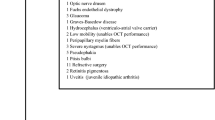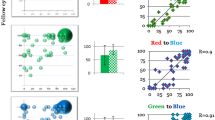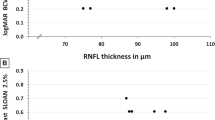Abstract
Multiple Sclerosis (MS) results in color vision impairment regardless of optic neuritis (ON). The exact location of injury remains undefined. The objective of this study is to identify the region leading to dyschromatopsia in MS patients’ NON-eyes. We evaluated Spearman correlations between color vision and measures of different regions in the afferent visual pathway in 106 MS patients. Regions with significant correlations were included in logistic regression models to assess their independent role in dyschromatopsia. We evaluated color vision with Hardy–Rand–Rittler plates and retinal damage using Optical Coherence Tomography. We ran SIENAX to measure Normalized Brain Parenchymal Volume (NBPV), FIRST for thalamus volume and Freesurfer for visual cortex areas. We found moderate, significant correlations between color vision and macular retinal nerve fiber layer (rho = 0.289, p = 0.003), ganglion cell complex (GCC = GCIP) (rho = 0.353, p < 0.001), thalamus (rho = 0.361, p < 0.001), and lesion volume within the optic radiations (rho = –0.230, p = 0.030). Only GCC thickness remained significant (p = 0.023) in the logistic regression model. In the final model including lesion load and NBPV as markers of diffuse neuroaxonal damage, GCC remained associated with dyschromatopsia [OR = 0.88 95 % CI (0.80–0.97) p = 0.016]. This association remained significant when we also added sex, age, and disease duration as covariates in the regression model. Dyschromatopsia in NON-eyes is due to damage of retinal ganglion cells (RGC) in MS. Color vision can serve as a marker of RGC damage in MS.

Similar content being viewed by others
References
Solomon SG, Lennie P (2007) The machinery of colour vision. Nat Rev Neurosci 8:276–286
Gegenfurtner KR (2003) Cortical mechanisms of colour vision. Nat Rev Neurosci 4:563–572
Evangelou N, Konz D, Esiri MM, Smith S, Palace J, Matthews PM (2001) Size-selective neuronal changes in the anterior optic pathways suggest a differential susceptibility to injury in multiple sclerosis. Brain 124:1813–1820
Sepulcre J, Goñi J, Masdeu JC, Bejarano B, Vélez de Mendizábal N, Toledo JB, Villoslada P (2009) Contribution of white matter lesions to gray matter atrophy in multiple sclerosis: evidence from voxel-based analysis of T1 lesions in the visual pathway. Arch Neurol 66:173–179
Castro SMC, Damasceno A, Damasceno BP, Vasconcellos JP, Reis F, Iyeyasu JN, Carvalho KM (2013) Visual pathway abnormalities were found in most multiple sclerosis patients despite history of previous optic neuritis. Arq Neuropsiquiatr 71:437–441
Martínez-Lapiscina EH, Ortiz-Pérez S, Fraga-Pumar E, Martínez-Heras E, Gabilondo I, Llufriu S, Bullich S, Figueras M, Saiz A, Sánchez-Dalmau B, Villoslada P (2014) Colour vision impairment is associated with disease severity in multiple sclerosis. Mult Scler 20:1207–1216
Moura ALDA, Teixeira RAA, Oiwa NN, Costa MF, Feitosa-Santana C, Callegaro D, Hamer RD, Ventura DF (2008) Chromatic discrimination losses in multiple sclerosis patients with and without optic neuritis using the Cambridge Colour Test. Vis Neurosci 25:463–468
Villoslada P, Cuneo A, Gelfand J, Hauser SL, Green A (2012) Color vision is strongly associated with retinal thinning in multiple sclerosis. Mult Scler 18:991–999
Martínez-Lapiscina EH, Fraga-Pumar E, Gabilondo I, Martínez-Heras E, Torres-Torres R, Ortiz-Pérez S, Llufriu S, Tercero A, Andorra M, Roca MF, Lampert E, Zubizarreta I, Saiz A, Sanchez-Dalmau B, Villoslada P (2014) The multiple sclerosis visual pathway cohort: understanding neurodegeneration in MS. BMC Res Notes 7:910
Cleary PA, Beck RW, Anderson MM, Kenny DJ, Backlund JY, Gilbert PR (1993) Design, methods, and conduct of the Optic Neuritis Treatment Trial. Control Clin Trials 14:123–142
Gabilondo I, Martínez-Lapiscina EH, Martínez-Heras E, Fraga-Pumar E, Llufriu S, Ortiz S, Bullich S, Sepulveda M, Falcon C, Berenguer J, Saiz A, Sanchez-Dalmau B, Villoslada P (2014) Trans-synaptic axonal degeneration in the visual pathway in multiple sclerosis. Ann Neurol 75:98–107
Cole BL, Lian KY, Lakkis C (2006) The new Richmond HRR pseudoisochromatic test for colour vision is better than the Ishihara test. Clin Exp Optom 89:73–80
Yushkevich PA, Piven J, Hazlett HC, Smith RG, Ho S, Gee JC, Gerig G (2006) User-guided 3D active contour segmentation of anatomical structures: significantly improved efficiency and reliability. Neuroimage 31:1116–1128
Sdika M, Pelletier D (2009) Nonrigid registration of multiple sclerosis brain images using lesion inpainting for morphometry or lesion mapping. Hum Brain Mapp 30:1060–1067
Fischl B, Rajendran N, Busa E, Augustinack J, Hinds O, Yeo BT, Mohlberg H, Amunts K, Zilles K (2008) Cortical folding patterns and predicting cytoarchitecture. Cereb Cortex 18:1973–1980
Desikan RS, Ségonne F, Fischl B, Quinn BT, Dickerson BC, Blacker D, Buckner RL, Dale AM, Maguire RP, Hyman BT, Albert MS, Killiany RJ (2006) An automated labeling system for subdividing the human cerebral cortex on MRI scans into gyral based regions of interest. Neuroimage 31:968–980
Zeki S, Watson JD, Lueck CJ, Friston KJ, Kennard C, Frackowiak RS (1991) A direct demonstration of functional specialization in human visual cortex. J Neurosci 11:641–649
Beauchamp MS, Haxby JV, Jennings JE, DeYoe EA (1999) An fMRI version of the farnsworth-munsell 100-hue test reveals multiple color-selective areas in human ventral occipitotemporal cortex. Cereb Cortex 9:257–263
Eickhoff SB, Stephan KE, Mohlberg H, Grefkes C, Fink GR, Amunts K, Zilles K (2005) A new SPM toolbox for combining probabilistic cytoarchitectonic maps and functional imaging data. Neuroimage 25:1325–1335
Saidha S, Al-Louzi O, Ratchford JN, Bhargava P, Oh J, Newsome SD, Prince JL, Pham D, Roy S, van Zijl P, Balcer LJ, Frohman EM, Reich DS, Crainiceanu C, Calabresi PA (2015) Optical coherence tomography reflects brain atrophy in MS: a four year study. Ann Neurol. doi:10.1002/ana.24487
Heesen C, Böhm J, Reich C, Kasper J, Goebel M, Gold SM (2008) Patient perception of bodily functions in multiple sclerosis: gait and visual function are the most valuable. Mult Scler 14:988–991
Huna-Baron R, Glovinsky Y, Habot-Wilner Z (2013) Comparison between Hardy-Rand-Rittler 4th edition and Ishihara color plate tests for detection of dyschromatopsia in optic neuropathy. Graefes Arch Clin Exp Ophthalmol 251:585–589
Walter SD, Ishikawa H, Galetta KM, Sakai RE, Feller DJ, Henderson SB, Wilson JA, Maguire MG, Galetta SL, Frohman E, Calabresi PA, Schuman JS, Balcer LJ (2012) Ganglion cell loss in relation to visual disability in multiple sclerosis. Ophthalmology 119:1250–1257
Hansen KA, Kay KN, Gallant JL (2007) Topographic organization in and near human visual area V4. J Neurosci 27:11896–11911
Heywood CA, Gadotti A, Cowey A (1992) Cortical area V4 and its role in the perception of color. J Neurosci 12:4056–4065
Acknowledgments
We are extremely grateful to the MS-VisualPath participants and fieldworkers without whose contribution this study would not be possible.
Author information
Authors and Affiliations
Corresponding author
Ethics declarations
Conflicts of interest
PV has received consultancy fees from Heidelberg Engineering regarding the clinical applications of OCT. On behalf of all authors, the corresponding author states that there is no conflict of interest for all other authors.
Funding
This study was supported by Instituto de Salud Carlos III, Spain: PS09/00259 and RD07/0060/01 to PV and RD12/0032/0002 to AS. EHML was supported by a fellowship from the Instituto de Salud Carlos III, Spain (Rio Hortega program: CM13/00150). The funding agencies had no role in the design and conduct of the study; collection, management, analysis, and interpretation of the data; or preparation, review, or approval of the manuscript.
Rights and permissions
About this article
Cite this article
Lampert, E.J., Andorra, M., Torres-Torres, R. et al. Color vision impairment in multiple sclerosis points to retinal ganglion cell damage. J Neurol 262, 2491–2497 (2015). https://doi.org/10.1007/s00415-015-7876-3
Received:
Revised:
Accepted:
Published:
Issue Date:
DOI: https://doi.org/10.1007/s00415-015-7876-3




